- Home
- Peter S. Beagle
We Never Talk About My Brother
We Never Talk About My Brother Read online
Table of Contents
COPYRIGHT
WE NEVER TALK ABOUT MY BROTHER
INTRODUCTION
UNCLE CHAIM AND AUNT RIFKE AND THE ANGEL
WE NEVER TALK ABOUT MY BROTHER
THE TALE OF JUNKO AND SAYURI
KING PELLES THE SURE
THE LAST AND ONLY, OR, MR. MOSCOWITZ BECOMES FRENCH
SPOOK
THE STICKBALL WITCH
BY MOONLIGHT
THE UNICORN TAPESTRIES
CHANDAIL
Copyright © 2008, 2015 by Avicenna Development Corporation. All rights reserved. Published in the United States of America by Conlan Press, Inc. An earlier edition was published in 2009 by Tachyon Publications, Inc. All current copyrights in the content are owned by and appear by permission of Avicenna Development Corporation.
The cover photo is by Sarah Allegra and is used by permission. Cover layout and design by Connor Cochran.
Conlan Press Ebook Release: 1.0
Release Date: November 2015
www.conlanpress.com
ISBN-13: 978-1-62-294005-9
The contents of this e-book were first published elsewhere:
“By Moonlight” ©2009 by Avicenna Development Corporation. First appeared in We Never Talk About My Brother (Tachyon Publications: San Francisco).
“Chandail” ©2007 by Peter S. Beagle and Avicenna Development Corporation. First appeared in Salon Fantastique: Fifteen Original Tales of Fantasy, edited by Ellen Datlow and Terri Windling (Thunder’s Mouth Press: New York).
“King Pelles the Sure,” “Spook,” and “Uncle Chaim and Aunt Rifke and the Angel” all copyright © 2008 by Avicenna Development Corporation. First appeared in Strange Roads by Peter S. Beagle (DreamHaven Books: Minneapolis).
“The Last and Only, or, Mr. Moscowitz Becomes French” ©2007 by Peter S. Beagle and Avicenna Development Corporation. First appeared in Eclipse One, edited by Jonathan Strahan (Night Shade Books: San Francisco).
“The Stickball Witch” copyright © 2008 by Avicenna Development Corporation. First appeared in We Never Talk About My Brother (Tachyon Publications: San Francisco). Derived from an original podcast performance recorded for the Green Man Review (www.greenmanreview.com) copyright © 2008 by Avicenna Development Corporation.
“The Tale of Junko and Sayuri” copyright © 2008 by Avicenna Development Corporation. First appeared in Intergalactic Medicine Show, July 2008, edited by Orson Scott Card.
“The Unicorn Tapestries” copyright © 1981 Peter S. Beagle.
“We Never Talk About My Brother” copyright © 2007 by Peter S. Beagle and Avicenna Development Corporation. First appeared in Orson Scott Card’s Intergalactic Medicine Show, July 2007.
To Jake and Phil, and Gunhill Road
WE NEVER TALK ABOUT MY BROTHER
By Peter S. Beagle
INTRODUCTION
By Charles de Lint
I think reading Peter Beagle was the first time I encountered an author who wrote fantasy novels set in this world we all live in. The only other one I can think of is James Branch Cabell, but he doesn’t count because, while he was writing contemporary-to-him fantasy, the first part of the 20th century was still an “otherworld” so far as I was concerned. And while authors such as Robert Nathan were certainly writing their own contemporary fantasies before Peter, I came to their books only after having read any number of Peter’s stories and novels.
As a reader, and later as a writer, I loved the immediacy of a contemporary setting, though like many writers in the 1970s, when I first tried my hand at fantasy I was as much locked into secondary worlds that pastiche Tolkien and Robert E. Howard as any of my peers. It took me a long time and more than a few books (many of which are still stuffed away in a box to never see the light of day) before I figured my way around it.
Peter doesn’t seem to ever have had that problem. Like another one of my favourite authors, the underrated Parke Godwin, Peter appears to move effortlessly between settings and makes them his own. Contemporary. Historical. Secondary world. You’d never mistake a Beagle book as a clone of the work of some other writer.
That first book of his that I read was A Fine and Private Place, a novel I was recently delighted to discover holds up as well today as it did when I first encountered it. Better perhaps, since I’m older now myself and understand the motivations of some of the characters in ways I couldn’t have when I first read it. That’s another mark of a good writer: when their books still speak to you and can show you something new, no matter how many times you reread them.
What does all of this have to do with the stories in hand? Not much, or maybe everything.
The ability to bring any time and place alive—even if it has never existed—is only one small part of Peter’s talent. More important, at least to this reader, is his ability to inhabit his characters.
Let me digress for a moment—I promise it will soon be relevant.
In music, singers touch us through their vocal skills, their tone (the quality of their voice), or their character—or more usually, some combination of the three. How we’re touched is subjective, of course, and differs from listener to listener. But what’s interesting is that a singer doesn’t need to be adept at every part of the equation to be successful.
Take someone like Céline Dion. She’s considered to be one of the world’s best singers but I can’t listen to her. She’s all vocal gymnastics without character.
Now consider Tom Waits. His pitch is good, but you wouldn’t consider him vocally skilled in a classical sense. The same goes for his tone, which can just as often resemble the growl of a misfiring engine or an animal’s howl. But the character of his voice? Unparalleled. For those of us who love his music, that’s what brings us back, time and again.
I don’t care how technically proficient a singer is, or how gorgeous his or her tone. If a voice doesn’t have character—if the singer doesn’t inhabit the song and make me believe it—I’m not interested.
It’s not quite the same in prose. Here the tone, which translates into the narrative voice of the character, is paramount. One writer’s literary skills might be more rudimentary than another’s (think, oh, Robert E. Howard as opposed to Michael Ondaatje), but if they can capture the right tone with their narration, then we’ll believe in the character and want to follow the story wherever it might lead us. That’s just the way it works. If we don’t believe in the character, why bother reading? Now, to stay with Howard for a moment, he’s a good example of great tone, but like many writers, that tone doesn’t vary much among his various stories because his characters are inevitably cut from a similar cloth.
There are differences in detail, but we always know we’re reading a Howard story.
That’s because it’s a lot more difficult to step into the skins of wildly varying characters than someone who hasn’t tried it might think. I read any number of writers who do one kind of character well, and I love them for it. But there are only a handful who can introduce us to any sort of a character, in any setting and time, and thoroughly inhabit that character’s skin.
Peter’s definitely one of those, and I offer the stories in this collection as indisputable evidence. His palette is rich with character colours and you’ll never mistake one for another.
Listen to the narrative voice when you read “We Never Talk About My Brother” and compare its down-home, small-town, Middle American tone to the lyric high fantasy of The Last Unicorn. Or the middle-aged protagonist of A Fine and Private Place with the eleven-year-old narrating “Uncle Chaim and Aunt Rifke and the Angel.” The distant voice telling us the story of “The Last and Only, or, Mr. Moscowitz Becomes French” bears not even a remote
resemblance to the easy modernity of the characters in “Spook” trying to rid an apartment of an annoying ghost.
We care about these characters because we believe in them. We want foolish King Pelles to find redemption. We need to understand the strange, mystic chandail as much as the narrator Lalkhamsin-khamsolal does; if she hates these sea creatures so much, why does she go to such lengths to preserve the life of the one she finds helpless on the shore? In “The Tale of Junko and Sayuri,” how far will Junko fall from his humanity using his wife’s shapechanging abilities to further his ambition? The last comment I want to make on these stories—and on Peter’s writing in general—is that no matter whose story he chooses to tell, or where and when it’s set, I doubt that his work will ever become uncomfortably dated. There’s a timelessness to even his most contemporary stories that will not allow them to seem quaint fifty years from now. I know this because that first book of his I read still felt fresh when I reread it some forty-six years after its initial publication. I know this because everything I read by him taps into the deep well of True Story that never grows old.
But don’t take my word for it. Read the stories that follow and see for yourself.
—Charles de Lint
Ottawa, Summer 2008
UNCLE CHAIM AND AUNT RIFKE AND THE ANGEL
This was the first story since my novel A Fine And Private Place that I drew specifically from my New York Jewish childhood. (“My Daughter’s Name Is Sarah,” based on a story from my mother’s childhood, was published later than A Fine and Private Place, but written a few years earlier.) It is also powerfully influenced by three of my mother’s four brothers, Raphael, Moses, and Isaac Soyer, who all became well-known painters in the New York realist style. As a child I spent a lot of time in my uncles’ studios, whether visiting or actually posing for them, and Uncle Chaim’s Greenwich Village atelier is based on my memory of Uncle Moses’ workplace. Uncle Moses wasn’t at all like my fictional Uncle Chaim in his speech and his mannerisms... but in terms of their attitudes toward their work, I do believe the real uncle and the imagined one would have understood each other.
My Uncle Chaim, who was a painter, was working in his studio—as he did on every day except Shabbos—when the blue angel showed up. I was there.
I was usually there most afternoons, dropping in on my way home from Fiorello LaGuardia Elementary School. I was what they call a “latchkey kid,” these days. My parents both worked and traveled fulltime, and Uncle Chaim’s studio had been my home base and my real playground since I was small. I was shy and uncomfortable with other children. Uncle Chaim didn’t have any kids, and didn’t know much about them, so he talked to me like an adult when he talked at all, which suited me perfectly. I looked through his paintings and drawings, tried some of my own, and ate Chinese food with him in silent companionship, when he remembered that we should probably eat. Sometimes I fell asleep on the cot. And when his friends—who were mostly painters like himself—dropped in to visit, I withdrew into my favorite corner and listened to their talk, and understood what I understood. Until the blue angel came.
It was very sudden: one moment I was looking through a couple of the comic books Uncle Chaim kept around for me, while he was trying to catch the highlight on the tendons under his model’s chin, and the next moment there was this angel standing before him, actually posing, with her arms spread out and her great wings taking up almost half the studio.
She was not blue herself—a light beige would be closer—but she wore a blue robe that managed to look at once graceful and grand, with a white undergarment glimmering beneath. Her face, half-shadowed by a loose hood, looked disapproving.
I dropped the comic book and stared. No, I gaped, there’s a difference.
Uncle Chaim said to her, “I can’t see my model. If you wouldn’t mind moving just a bit?” He was grumpy when he was working, but never rude.
“I am your model,” the angel said. “From this day forth, you will paint no one but me.”
“I don’t work on commission,” Uncle Chaim answered. “I used to, but you have to put up with too many aggravating rich people. Now I just paint what I paint, take it to the gallery. Easier on my stomach, you know?”
His model, the wife of a fellow painter, said, “Chaim, who are you talking to?”
“Nobody, nobody, Ruthie. Just myself, same way your Jules does when he’s working. Old guys get like that.” To the angel, in a lower voice, he said, “Also, whatever you’re doing to the light, could you not? I got some great shadows going right now.” For a celestial brightness was swelling in the grubby little warehouse district studio, illuminating the warped floor boards, the wrinkled tubes of colors scattered everywhere, the canvases stacked and propped in the corners, along with several ancient rickety easels. It scared me, but not Uncle Chaim. He said. “So you’re an angel, fine, that’s terrific. Now give me back my shadows.”
The room darkened obediently. “Thank you. Now about moving....” He made a brushing-away gesture with the hand holding the little glass of Scotch.
The model said, “Chaim, you’re worrying me.”
“What, I’m seventy-six years old, I’m not entitled to a hallucination now and then? I’m seeing an angel, you’re not—this is no big deal. I just want it should move out of the way, let me work.” The angel, in response, spread her wings even wider, and Uncle Chaim snapped, “Oh, for God’s sake, shoo!”
“It is for God’s sake that I am here,” the angel announced majestically. “The Lord—Yahweh—I Am That I Am—has sent me down to be your muse.” She inclined her head a trifle, by way of accepting the worship and wonder she expected.
From Uncle Chaim, she didn’t get it, unless very nearly dropping his glass of Scotch counts as a compliment. “A muse?” he snorted. “I don’t need a muse—I got models!”
“That’s it,” Ruthie said. “I’m calling Jules, I’ll make him come over and sit with you.” She put on her coat, picked up her purse, and headed for the door, saying over her shoulder, “Same time Thursday? If you’re still here?”
“I got more models than I know what to do with,” Uncle Chaim told the blue angel. “Men, women, old, young—even a cat, there’s one lady always brings her cat, what am I going to do?” He heard the door slam, realized that Ruthie was gone, and sighed irritably, taking a larger swallow of whiskey than he usually allowed himself. “Now she’s upset, she thinks she’s my mother anyway, she’ll send Jules with chicken soup and an enema.” He narrowed his eyes at the angel. “And what’s this, how I’m only going to be painting you from now on? Like Velazquez stuck painting royal Hapsburg imbeciles over and over? Some hope you’ve got! Listen, you go back and tell, ”—he hesitated just a trifle—“tell whoever sent you that Chaim Malakoff is too old not to paint what he likes, when he likes, and for who he likes. You got all that? We’re clear?”
It was surely no way to speak to an angel; but as Uncle Chaim used to warn me about everyone from neighborhood bullies to my fourth-grade teacher, who hit people, “You give the bastards an inch, they’ll walk all over you. From me they get bupkes, nichevo, nothing. Not an inch.” I got beaten up more than once in those days, saying that to the wrong people.
And the blue angel was definitely one of them. The entire room suddenly filled with her: with the wings spreading higher than the ceiling, wider than the walls, yet somehow not touching so much as a stick of charcoal; with the aroma almost too impossibly haunting to be borne; with the vast, unutterable beauty that a thousand medieval and Renaissance artists had somehow not gone mad (for the most part) trying to ambush on canvas or trap in stone. In that moment, Uncle Chaim confided later, he didn’t know whether to pity or envy Muslims their ancient ban on depictions of the human body.
“I thought maybe I should kneel, what would it hurt? But then I thought, what would it hurt? It’d hurt my left knee, the one had the arthritis twenty years, that’s what it would hurt.” So he only shrugged a little and told her, “I could manage a sitting on
Monday. Somebody cancelled, I got the whole morning free.”
“Now,” the angel said. Her air of distinct disapproval had become one of authority. The difference was slight but notable.
“Now,” Uncle Chaim mimicked her. “All right, already—Ruthie left early, so why not?” He moved the unfinished portrait over to another easel, and carefully selected a blank canvas from several propped against a wall. “I got to clean off a couple of brushes here, we’ll start. You want to take off that thing, whatever, on your head?” Even I knew perfectly well that it was a halo, but Uncle Chaim always told me that you had to start with people as you meant to go on.
“You will require a larger surface,” the angel instructed him. “I am not to be represented in miniature.”
Uncle Chaim raised one eyebrow (an ability I envied him to the point of practicing—futilely—in the bathroom mirror for hours, until my parents banged on the door, certain I was up to the worst kind of no good).
“No, huh? Good enough for the Persians, good enough for Holbein and Hilliard and Sam Cooper, but not for you? So okay, so we’ll try this one....” Rummaging in a corner, he fetched out his biggest canvas, dusted it off, eyed it critically—“Don’t even remember what I’m doing with anything this size, must have been saving it for you”—and finally set it up on the empty easel, turning it away from the angel. “Okay, Malakoff ’s rules. Nobody—nobody—looks at my painting till I’m done. Not angels, not Adonai, not my nephew over there in the corner, that’s David, Duvidl—not even my wife. Nobody. Understood?”
The angel nodded, almost imperceptibly. With surprising meekness, she asked, “Where shall I sit?”
“Not a lot of choices,” Uncle Chaim grunted, lifting a brush from a jar of turpentine. “Over there’s okay, where Ruthie was sitting—or maybe by the big window. The window would be good, we’ve lost the shadows already. Take the red chair, I’ll fix the color later.”

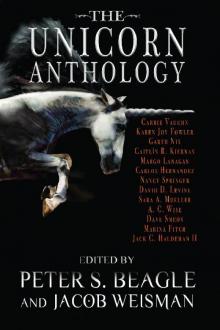 The Unicorn Anthology.indb
The Unicorn Anthology.indb Sleight of Hand
Sleight of Hand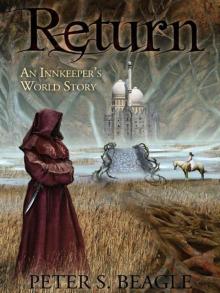 Return
Return The Last Unicorn
The Last Unicorn Two Hearts
Two Hearts Mirror Kingdoms: The Best of Peter S. Beagle
Mirror Kingdoms: The Best of Peter S. Beagle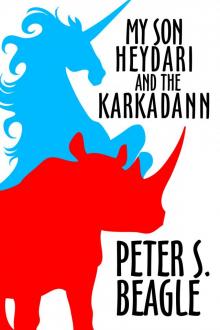 My Son Heydari and the Karkadann
My Son Heydari and the Karkadann The Magician of Karakosk, and Other Stories
The Magician of Karakosk, and Other Stories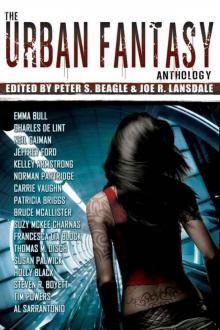 The Urban Fantasy Anthology
The Urban Fantasy Anthology The Story of Kao Yu
The Story of Kao Yu The Karkadann Triangle
The Karkadann Triangle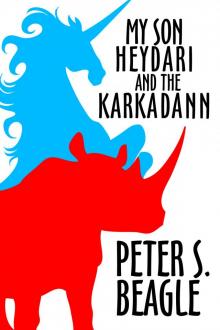 My Son and the Karkadann
My Son and the Karkadann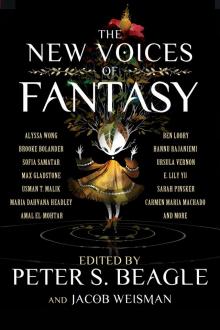 The New Voices of Fantasy
The New Voices of Fantasy A Dance for Emilia
A Dance for Emilia We Never Talk About My Brother
We Never Talk About My Brother The Folk Of The Air
The Folk Of The Air The Magician of Karakosk: Tales from the Innkeeper's World
The Magician of Karakosk: Tales from the Innkeeper's World A Fine and Private Place
A Fine and Private Place Lila The Werewolf
Lila The Werewolf Tamsin
Tamsin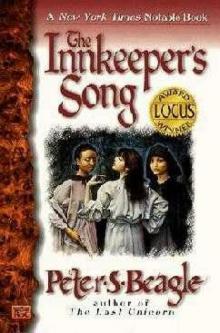 Innkeeper's Song
Innkeeper's Song